Related Research Articles

Trophallaxis is the transfer of food or other fluids among members of a community through mouth-to-mouth (stomodeal) or anus-to-mouth (proctodeal) feeding. Along with nutrients, trophallaxis can involve the transfer of molecules such as pheromones, organisms such as symbionts, and information to serve as a form of communication. Trophallaxis is used by some birds, gray wolves, vampire bats, and is most highly developed in eusocial insects such as ants, wasps, bees, and termites.

Behavioral ecology, also spelled behavioural ecology, is the study of the evolutionary basis for animal behavior due to ecological pressures. Behavioral ecology emerged from ethology after Niko Tinbergen outlined four questions to address when studying animal behaviors: What are the proximate causes, ontogeny, survival value, and phylogeny of a behavior?

Carpenter bees are species in the genus Xylocopa of the subfamily Xylocopinae. The genus includes some 500 bees in 31 subgenera. The common name "carpenter bee" derives from their nesting behavior; nearly all species burrow into hard plant material such as dead wood or bamboo. The main exceptions are species in the subgenus Proxylocopa, which dig nesting tunnels in suitable soil.

Apparent death is a behavior in which animals take on the appearance of being dead. It is an immobile state most often triggered by a predatory attack and can be found in a wide range of animals from insects and crustaceans to mammals, birds, reptiles, amphibians, and fish. Apparent death is separate from the freezing behavior seen in some animals.

The tribe Euglossini, in the subfamily Apinae, commonly known as orchid bees or euglossine bees, are the only group of corbiculate bees whose non-parasitic members do not all possess eusocial behavior.

Xylocopa virginica, sometimes referred to as the eastern carpenter bee, extends through the eastern United States and into Canada. They are sympatric with Xylocopa micans in much of southeastern United States. They nest in various types of wood and eat pollen and nectar. In X. virginica, dominant females do not focus solely on egg-laying, as in other bee species considered to have "queens". Instead, dominant X. virginica females are responsible for a full gamut of activities including reproduction, foraging, and nest construction, whereas subordinate bees may engage in little activity outside of guarding the nest.
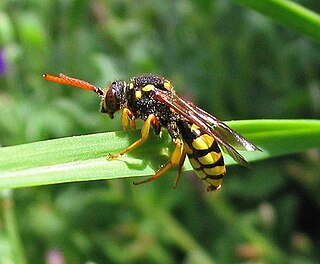
With over 850 species, the genus Nomada is one of the largest genera in the family Apidae, and the largest genus of cuckoo bees. Cuckoo bees are so named because they enter the nests of a host and lay eggs there, stealing resources that the host has already collected. The name "Nomada" is derived from the Greek word nomas, meaning "roaming" or "wandering."

Oophagy or ovophagy, literally "egg eating", is the practice of embryos feeding on eggs produced by the ovary while still inside the mother's uterus. The word oophagy is formed from the classical Greek ᾠόν and classical Greek φᾱγεῖν. In contrast, adelphophagy is the cannibalism of a multi-celled embryo.
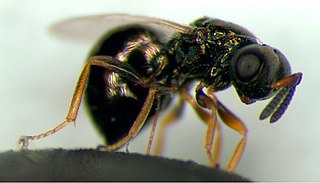
Nasonia vitripennis is one of four known species under the genus Nasonia - small parasitoid wasps that afflict the larvae of parasitic carrion flies such as blowflies and flesh flies, which themselves are parasitic toward nestling birds. It is the best known and most widely studied of the parasitoid wasps, and their study forms a vital part of the information used to describe the order Hymenoptera, along with information from bees and ants. This parasitoid behaviour makes the wasps an interest for the development of biopesticide and biological systems for controlling unwanted insects.
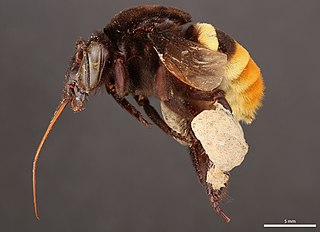
Eulaema is a genus of large-bodied euglossine bees that occur primarily in the Neotropics. They are robust brown or black bees, hairy or velvety, and often striped with yellow or orange, typically resembling bumblebees. They lack metallic coloration as occurs in the related genus Eufriesea.
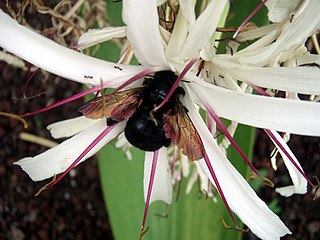
Xylocopa sonorina, the valley carpenter bee or Hawaiian carpenter bee, is a species of carpenter bee found from western Texas to northern California, and the eastern Pacific islands. Females are black while males are golden-brown with green eyes.

The California carpenter bee, Xylocopa californica, is a species of carpenter bee in the order Hymenoptera, and it is native to western North America.

Lasioglossum zephyrus is a sweat bee of the family Halictidae, found in the U.S. and Canada. It appears in the literature primarily under the misspelling "zephyrum". It is considered a primitively eusocial bee, although it may be facultatively solitary. The species nests in burrows in the soil.
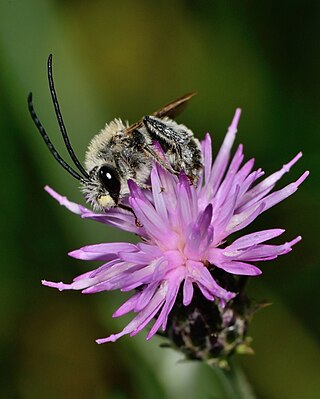
Eucera is a genus of bees in the family Apidae, which comprises more than 100 species. These bees are commonly known as long-horned bees due to their characteristically long antennae, especially in males. Eucera species can be found in diverse habitats, including meadows, fields, and urban gardens, primarily in the Palearctic and Nearctic regions, covering parts of Europe, Asia, North Africa, and North America.
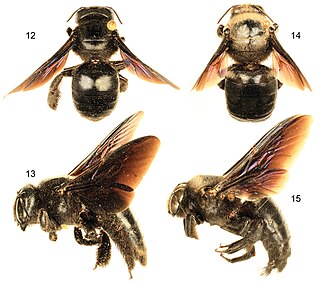
Xylocopa sulcatipes is a large Arabian carpenter bee. These multivoltine bees take part in social nesting and cooperative nesting. They are metasocial carpenter bees that nest in thin dead branches. One or more cooperating females build many brood cells. They have been extensively studied in Saudi Arabia and Israel.
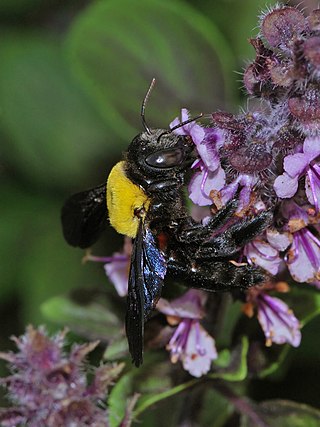
Xylocopa pubescens is a species of large carpenter bee. Females form nests by excavation with their mandibles, often in dead or soft wood. X. pubescens is commonly found in areas extending from India to Northeast and West Africa. It must reside in these warm climates because it requires a minimum ambient temperature of 18 °C (64 °F) in order to forage.

Augochlora pura is a solitary sweat bee found primarily in the Eastern United States. It is known for its bright green color and its tendency to forage on a variety of plants. Inhabiting rotting logs, this bee can produce up to three generations per year. Both males and females have been observed licking sweat from human skin, most likely seeking salt

Xylocopa micans, also known as the southern carpenter bee, is a species of bee within Xylocopa, the genus of carpenter bees. The southern carpenter bee can be found mainly in the coastal and gulf regions of the southeastern United States, as well as Mexico and Guatemala. Like all Xylocopa bees, X. micans bees excavate nests in woody plant material. However, unlike its sympatric species Xylocopa virginica, X. micans has not been found to construct nest galleries in structural timbers of building, making it less of an economic nuisance to humans. Carpenter bees have a wide range of mating strategies between different species. The southern carpenter bee exhibits a polymorphic mating strategy, with its preferred method of mating changing as the season progresses from early spring to mid summer. Like most bees in its genus, the southern carpenter bee is considered a solitary bee because it does not live in colonies.

The tiger bee fly, Xenox tigrinus, is an insect of the family Bombyliidae found in the eastern United States and southern Ontario. It formerly went by the name Anthrax tigrinus. The distinctive wing pattern may resemble tiger stripes, giving the tiger bee fly its name. Like other members of the bee fly family, the tiger bee fly parasitizes the larvae of other insects.
George Bunker Chapman was a professor and a pioneer in research of cell biology and ultrastructure using transmission-light and transmission electron microscopy. He was the first person to see the interior structure of four bacterium species in electron micrographs he produced, described in his Ph.D. dissertation completed in 1953. As a professor, he changed the lives of hundreds of students, colleagues, and others through his mentorship.
References
- ↑ Barrows, E. M.; Bell, W. J. & Michener, C. D. (July 1975). "Individual odor differences and their social functions in insects". Proceedings of the National Academy of Sciences. 72 (7): 2824–2828. Bibcode:1975PNAS...72.2824B. doi: 10.1073/pnas.72.7.2824 . ISSN 0027-8424. PMC 432864 . PMID 1058498.
- ↑ Barrows, E. M. (1983). "Male territoriality in the carpenter bee Xylocopa virginica virginica". Animal Behaviour. 31 (3): 806–813. doi:10.1016/S0003-3472(83)80237-1. ISSN 0003-3472. S2CID 53178858.
- ↑ Barrows, E. M.; Acquavella, A. P.; Weinstein, J. P. S. & Nosal, R. E. (1980). "Response to novel food in captive, juvenile mockingbirds". Wilson Bulletin. 92: 339–402. ISSN 0043-5643.
- ↑ Barrows, E. M. (1978). "Behavioural changes during recovery from injury in captive, juvenile mockingbirds". Avicultural Magazine. 84: 191–197.
- ↑ Kjar, D. S. & Barrows, E. M. (2004). "Arthropod community heterogeneity in a Mid-Atlantic forest highly invaded by alien organisms". Banisteria. 24: 26–37. ISSN 1066-0712. (About Dyke Marsh Wildlife Preserve, VA)
- ↑ Barrows, E. M.; Mcintyre, A. M. & Flint, O. S. Jr. (2005). "Alderfly (Neuroptera: Sialidae) flight periods, sex ratios, and habitat use in a Virginia freshwater tidal marsh, low forest, and their ecotones". Proceedings of the Washington Entomological Society. 107: 693–699. ISSN 0013-8797.
- ↑ Barrows, E. M. & Smith, D. R. (September 2014). "Sawflies (Hymenoptera: Symphyta) of three Mid-Atlantic parks in the George Washington Memorial Parkway, USA". Journal of Hymenoptera Research. 39: 17–31. doi: 10.3897/JHR.39.7907 . ISSN 1070-9428.
- ↑ Howard, A. F. & Barrows, E. M. (June 2014). "Self-pollination rate and floral-display size in Asclepias syriaca (Common Milkweed) with regard to floral-visitor taxa". BMC Evolutionary Biology. 14 (1): 144. Bibcode:2014BMCEE..14..144H. doi: 10.1186/1471-2148-14-144 . ISSN 1471-2148. PMC 4080991 . PMID 24958132.
- ↑ Boyle, H. & Barrows, E. M. (1978). "Oviposition and host feeding behavior of Aphelinus asychis (Hymenoptera: Chalcidoidea: Aphelinidae) on Schizaphis graminum (Homoptera: Aphidae) and some reactions of aphids to this parasite". Proceedings of the Entomological Society of Washington. 80: 441–455. ISSN 0013-8797.
- ↑ Barrows, E. M. & Hooker, M. E. (1981). "Parasitization of Mexican bean beetles in urban vegetable gardens". Environmental Entomology. 10: 782–786. doi:10.1093/ee/10.5.782. ISSN 0046-225X.
- ↑ Tsai, Yi-Jiun J.; Barrows, E. M. & Weiss, M. R. (August 2014). "Pure self-assessment of size During male-male contests in the parasitoid wWasp Nasonia vitripennis". Ethology. 120 (8): 816–824. Bibcode:2014Ethol.120..816T. doi:10.1111/eth.12254. ISSN 0014-1828.
- ↑ Tsai, Yi-Jiun J.; Barrows, E. M. & Weiss, M. R. (May 2014). "Why do larger and older males win contests in the parasitoid wasp Nasonia vitripennis?". Animal Behaviour. 91: 150–158. doi:10.1016/j.anbehav.2014.03.010. ISSN 0003-3472. S2CID 53171325.
- ↑ Barrows, E. M.; Howard, A. F. & Steury, B. W. (2012). "Fruit production and phenology of Phacelia covillei S. Watson (Hydrophyllaceae) in the Potomac Gorge area of Maryland and Virginia". Marilandica. 3 (1): 10–16. OCLC 59759744.